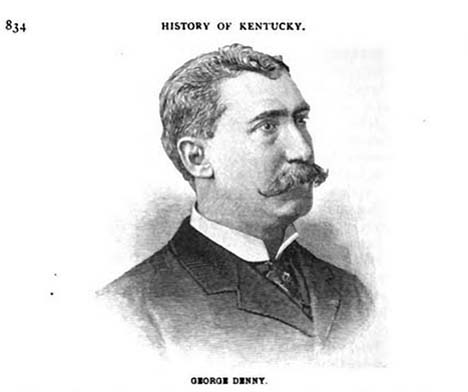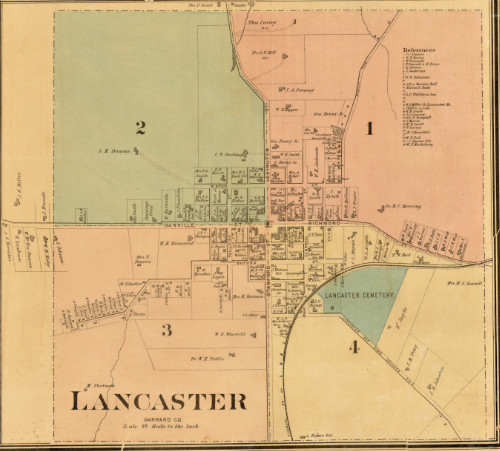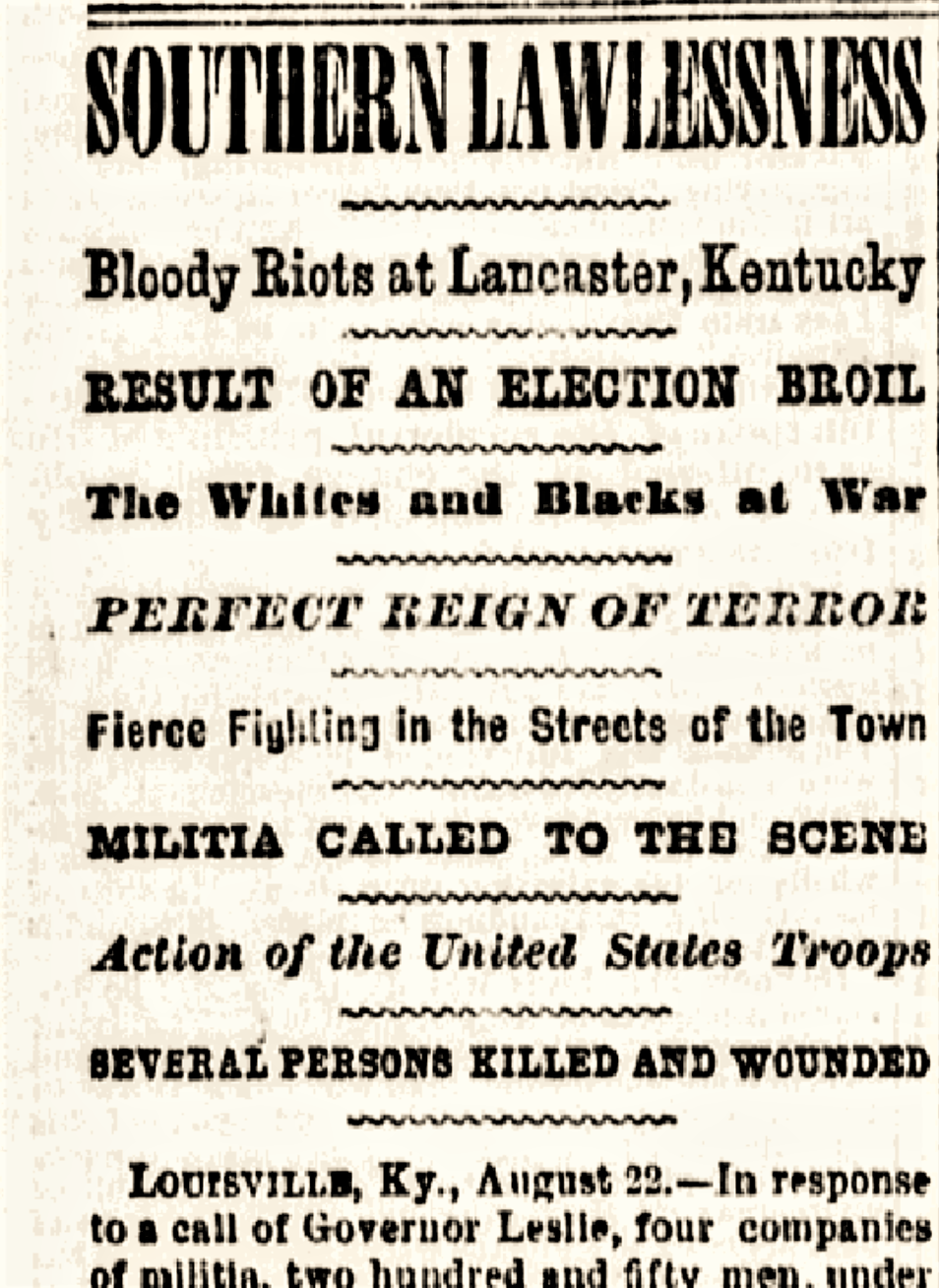


Map of Garrard County showing the four election precincts. Buckeye, the precinct in which Sellers lived, is highlighted.
Garrard County, 1870

George Denny, Jr., one of the Garrard Republican Party elite along with William Sellers. (Z. F. Smith, History of Kentucky.
(Louisville, Ky: Job Printing, 1892)

Detail from the 1879 Beers and Lanagan Land Ownership Map of Garrard and Lincoln Counties showing the town of Lancaster. The courthouse, in the center of town, is labeled.
University of Wisconsin-Milwaukee Libraries

The Kennedy-Sellers riot made headlines across the country. A detailed two column story appeared in the Indiana State Sentinel on September 1, 1874
The Kennedy-Sellers Riot of 1874
A dispute over the accuracy of an election result led to the Kennedy-Sellers riot in August 1874. This violent confrontation reduced Lancaster, a town of over 1,000 people and the seat of government for Garrard County, to near anarchy. Federal troops and state militia were brought in as part of the effort to quell the week-long violence in Lancaster’s town square.
Some of the central players in this dangerous moment were characters from George Denny Jr’s Republican steering group. Others were Democratic partisans determined to remain in power, regardless of election outcomes and, in the process, to ensure that African Americans did not become a political force.
The Republican Leader
William R. Sellers, a man from a modest, non-slave-owning family, resided in the Buckeye precinct. The precinct was mostly white and a major source of the white Republican vote that was key to the Republican Party’s cross-racial coalition. Sellers served in the Civil War, on General George Thomas’ staff. Like Denny, he quickly established a career in the newly created Republican Party of Garrard County. He and Denny soon became close, and Sellers served, with another member of the local Republican Party elite, William O. Bradley, as bondsmen at Denny’s 1870 marriage. After Denny and fellow Republican candidates swept into county offices in the August 1870 election, Sellers ran for and won the Garrard County seat in the Kentucky House of Representatives in August 1871. He was re-elected in August 1873 as a Republican member of the Kentucky House and was the most senior political figure in Garrard County as the riots swept over Lancaster.
From his first election onwards, Sellers’ life became far more combative and litigious. He often found himself pulled into Denny’s many legal disputes and contentious prosecutions. Financial difficulties added to Sellers legal troubles when in March 1874 a major fire on the Lancaster town square, thought to have been deliberately lit, destroyed his woefully underinsured hardware store along with many other businesses.
However, it was a dispute over the results of the Monday, August 3, 1874 county election that would result in the destruction of his family home and entangle Sellers in court battles that stretched on for nearly a decade
A Democrat Incumbent Loses
Elbert D. Kennedy, a 59-year-old Democrat from a large and notorious family that owned much of the land around Crab Orchard in neighboring Lincoln County, was the incumbent circuit court clerk and had previously served as the Todd County sheriff.
Like several other candidates on the Democratic ticket, Kennedy lost the August 1874 election to his Republican challenger, J. K. Faulkner. Faulkner’s margin was slight — as few as 11 votes. Kennedy indicated he would contest the election on behalf of the losing Democratic ticket, alleging Denny and Sellers’ Republican machine had mobilized ineligible black men to vote.
The contested election hearing was scheduled for August 22. As that date grew nearer, tensions between Democrats and Republicans in the town intensified, with both sides becoming, in the words of a local newspaper, the Stanford Interior Journal, “unduly excited” (Stanford Interior Journal, August 28, 1874).
Violence Erupts
The examination board failed to resolve the election dispute when it met in the days following the election. According to an account from Sellers, late on Friday, August 7, a drunken Kennedy confronted Sellers near the Lancaster courthouse and, rather uncoordinatedly, tried to shoot him. Sellers fired first, but “only slightly wounded” Kennedy (Louisville Courier Journal, August 28, 1874; Stanford Interior Journal, August 28, 1874). On Monday morning, Kennedy returned to his pre-election office in the county courthouse, perhaps persuaded by the oldest of adages that possession is nine tenths of the law, but certainly further inflaming the situation.
There was some animosity between Kennedy and Sellers. As one of the few Democrats still in a position in the county government, however uncertain, Kennedy was naturally suspicious of Sellers. Sellers was a key part of the Denny machine, determined to maintain Republican control of the top officials of Garrard County and to have colleagues at the state and federal level. Additionally, Sellers was a cousin of J. W. West, the Republican candidate for county clerk, and, Kennedy alleged, Sellers had said that West “should be elected at all hazards” (Louisville Courier Journal, September 5, 1874).
After their drunken encounter near the courthouse, the dispute was understood as one between Sellers and his Republican men on one side and Kennedy’s Democrats on the other.
In the following weeks, a crew of white men holed up with Kennedy in the courthouse to defend him, Kennedy insisted, against an attack from African Americans directed by Sellers and his fellow white politicians. A group of Republican men, black and white, gradually congregated in Sellers’ house. Violence broke out by August 19 and continued for several days, with newspapers across the nation reporting about the “sanguinary riot” (New York Times, August 23, 1874, p. 8), a “reign of terror” (Boston Daily Advertiser, August 24, 1874), and a “war in Kentucky” (Baltimore Sun, August 24, 1874, p. 1). Sellers’ house was set on fire and destroyed; Kennedy alleged his house was set on fire, but the fire was extinguished. Several men, mostly black, were killed, and more, including Kennedy’s brother-in-law, Fred Yeakey, were shot. Neither Sellers nor Kennedy were still in Lancaster for the most violent days.
Federal troops were called in to quell the violence and four companies of the state militia, 240 men in all, well-armed, arrived in town on August 23rd. Peace returned to Lancaster and Garrard County.
The contested election hearing scheduled for August 22 never happened and it would take almost a year for the election result to be finalized by the Circuit Court.
A Powerful Republican Party Machine
After the siege had ended, Kennedy laid out his rationale for contesting the election in the first place, which centered on malfeasance by a well-organized Republican machine mobilizing black voters.
Kennedy’s position was that the vote from Sellers’ Buckeye precinct should not be included in the election result. In an extraordinary letter to the Louisville Courier Journal, Kennedy explained that election officials had improperly handled the poll book from the Buckeye precinct and, more importantly, that “many negroes voting for Col. Faulkner were imported from other counties – other negroes voted for him twice, and many others who were under age” (Louisville Courier Journal, September 5, 1874). In total, Kennedy contested 155 votes.
That exclusion of the Buckeye votes would ensure Kennedy’s re-election, result in the defeat of West and Faulkner, and place another Democrat in the powerful county clerk position. It was an ambitious power play.
The Usual Way of Resolving Election Disputes
Whether or not these allegations were supported by evidence is unclear, as we have not uncovered the poll books for the August 1874 election. However, at the time, resolving the dispute should have been simple: refer to the poll books. Since every vote was attached to a named person, the challenge should have identified and investigated the status of each disputed vote and decided the outcome by removing those deemed invalid from the tally. This was the technique used in other contested election cases in viva voce systems, including the disputed outcome in the November 1868 race between Sidney M. Barnes (Republican) and George M. Adams (Democrat) in Kentucky’s 8th congressional district, which included Garrard County.
Kennedy Chooses a Different Way
Rather than disputing individual voters using the poll books, Kennedy “notified” the board examining the election “not to take into consideration a roll of papers which had been delivered to the county clerk purporting to be the poll book of Buckeye voting precinct.” This was an outrageous proposition and one which did not aid the timely resolution of the dispute.
After three days of deliberation, one of the three members of the examining board that met immediately after the August election delivered Kennedy and the Democratic candidate for county clerk certificates declaring him elected. On the same day, August 7, the other two members delivered a signed statement to Faulkner and the Republican candidate (West) for county clerk certifying their election. Rather than mediate and resolve the election dispute, the examining board amplified the dispute. Perhaps a different outcome would have been possible if the conventional, poll book-driven method of resolving election disputes had been employed.
Why Violence Around Elections?
The Kennedy-Sellers riot was but one of the incidences of election violence in Garrard County. In Todd County, just 150 miles to the southeast, there was almost no election day violence. The reason for this difference seems to stem from the successful Republican organization in Garrard County. An alliance between black and white Republicans, which frequently elected candidates to county government and to state office, threatened the old white order. Correspondingly, intense violence accompanied many elections, especially those for county and district office. On Election Day, black men were a highly visible part of Republican Party victories and violence between white Democrats and Republicans of both races was common.
By contrast, in Todd County there was little election-time violence because black participation, while substantial, did not challenge the established order. Black men enthusiastically participated in Todd elections, but Republicans seldom won. The county was safely in the hands of the Democratic Party. Instead, African Americans in Todd County, endured vicious nighttime attacks by the Ku Klux Klan, who targeted not politically active African American men but those who used federal laws to upset the social order. What is common to Garrard and Todd counties is the timing of the violence: the early 1870s, targeted at the clearest manifestation of a changed social and political order in the two counties.








